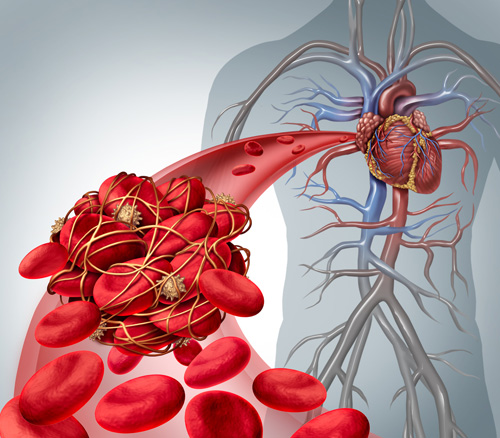Deep Vein Thrombosis (DVT)

What is deep vein thrombosis?
Deep vein thrombosis (DVT) is a serious condition that occurs when a blood clot forms in a vein located deep inside your body. A blood clot is a clump of blood that is in a gelatinous, solid state. Deep vein blood clots typically form in your thigh or lower leg, but they can also develop in other areas of your body. Other names for this condition include thromboembolism, post-thrombotic syndrome, and post-phlebitic syndrome.
Conditions that alter how your blood moves through your veins can raise your risk of developing clots. These include:
- having an injury that damages your veins
- surgical procedures that cause the patient to be non-ambulatory
- being overweight, which puts more pressure on the veins in your legs and pelvis
- having a family history of DVT
- having a catheter placed in a vein
- taking birth control pills or undergoing hormone therapy
- smoking (especially heavy usage)
Staying seated for a long time while you’re in a car or on a plane, especially if you already have at least one other risk factor
Some diseases and disorders can increase your risk of having blood clots. These include hereditary blood clotting disorders, especially when you have at least one other risk factor. Cancer and inflammatory bowel disease can also increase the risk of developing a blood clot. Heart failure, a condition that makes it more difficult for your heart to pump blood, also occurs with an increased risk of clots.
Surgery
DVT is a major risk associated with surgery. This is especially true if you’re having a surgery in the lower extremities, such as joint replacement surgery. Your doctor will discuss the risk of DVT if you need joint replacement surgery.
Pregnancy
Being pregnant increases your risk of DVT. Increased hormone levels, and a slower blood flow as your uterus expands and restricts blood flowing back from your lower extremities, contribute to this risk. This elevated risk continues until about six weeks after giving birth. Being on bed rest or having a C-section also increases your risk of having DVT.
DVT treatments focus on keeping the clot from growing. In addition, treatment will attempt to prevent a pulmonary embolism and lower your risk of having more clots.
What are the symptoms of deep vein thrombosis?
Symptoms
According to the National Heart, Lung, and Blood Institute, symptoms of DVT only occur in about half of the people who have this condition. Common symptoms include:
- swelling in your foot, ankle, or leg, usually on one side
- cramping pain in your affected leg that usually begins in your calf
- severe, unexplained pain in your foot and ankle
- an area of skin that feels warmer than the skin on the surrounding areas
- skin over the affected area turning pale or a reddish or bluish color
People may not find out that they have deep vein thrombosis until they’ve gone through emergency treatment for a pulmonary embolism. A pulmonary embolism is a life-threatening complication of DVT in which an artery in the lung becomes blocked.
What are the treatment options for deep vein thrombosis?
DVT treatments focus on keeping the clot from growing. In addition, treatment will attempt to prevent a pulmonary embolism and lower your risk of having more clots
Treatment
DVT treatments focus on keeping the clot from growing. In addition, treatment will attempt to prevent a pulmonary embolism and lower your risk of having more clots.
Medication
Your doctor might prescribe medications that thin your blood, such as heparin and warfarin. This makes it harder for your blood to clot. It also keeps existing clots as small as possible and decreases the chance that you’ll develop more clots.
DVT Compression Devices
Wearing compression sleeves/pumps can prevent swelling and lower extremities and reduce your chance of developing clots. They wrap around your calves and have pump blood in your vessels.These are worn while the patient is non-ambulatory(while sitting or standing). They are prescribed by your physician and should be used with their instruction.
What are the complications associated with deep vein thrombosis?
Complications
A major complication of DVT is a pulmonary embolism. You can develop a pulmonary embolism if a blood clot moves to your lungs and blocks a blood vessel. This can cause serious damage to your lungs and other parts of your body. You should get immediate medical help if you have signs of a pulmonary embolism. These signs include:
- dizziness
- sweating
- chest pain that gets worse with coughing or inhaling deeply
- rapid breathing
- coughing up blood
- rapid heart rate
